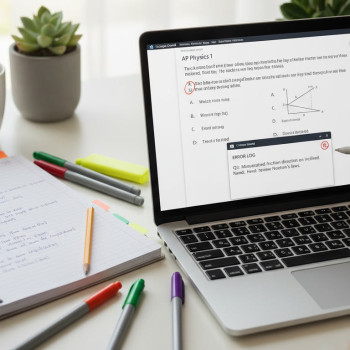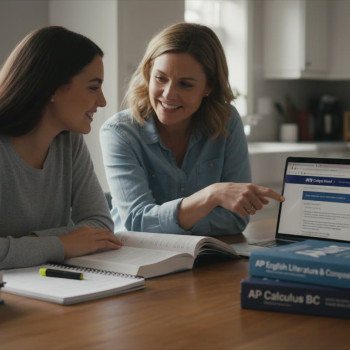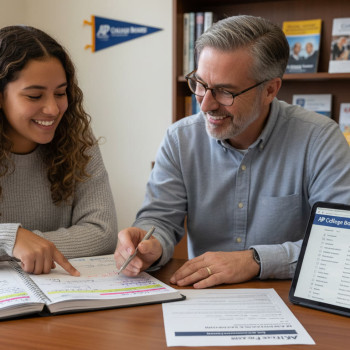Why This Bridge Matters: CBSE Foundations and the AP World
Switching from CBSE math topics like vectors and probability to the AP universe—specifically AP Calculus and AP Statistics—feels like stepping onto a bigger stage. The math is familiar, but expectations, notation, and problem style can differ. This blog is a friendly, practical guide for students and parents who want a clear map of how those CBSE topics become powerful tools in AP courses and exams.

Who this is for
If you’re a CBSE student planning to take AP Calculus AB/BC or AP Statistics (or you’re a parent helping plan the journey), this piece is for you. You’ll get explanations that connect concepts, study strategies that respect both curricula, worked examples that show how skills translate, and practical next steps. We’ll also highlight where targeted, one-on-one help like Sparkl’s personalized tutoring can accelerate progress.
Big-picture connections: How Vectors and Probability Feed AP Calculus and AP Statistics
Before diving into examples, let’s outline the big ideas. CBSE vectors and probability teach ways of modeling and reasoning that are directly useful in AP courses:
- Vectors introduce geometric thinking, parametric representations, and the algebra of multi-component quantities—skills that make parametric and vector-valued functions in AP Calculus much easier.
- Probability builds intuition about randomness, expected value, and distributional thinking, which are foundational for probability models and inference in AP Statistics.
- Both areas emphasize problem solving and clear communication—core skills for AP free-response questions.
How teachers test different skills
CBSE often emphasizes precise solution methods and multi-step algebraic manipulation, while AP tests higher-order application, interpretation, and explanation. That means a student who masters CBSE mechanics will likely need extra practice translating their answers into AP-style reasoning and language (e.g., interpreting a derivative in context or explaining a statistical inference in words).
Vectors: From CBSE Geometry to AP Calculus Applications
Vectors in CBSE build the language of direction and magnitude, dot and cross products, and vector equations of lines and planes. On the AP side, vectors pop up in several ways:
- Parametric curves and motion problems in AP Calculus: position, velocity, and acceleration are naturally vector-valued.
- Understanding slopes and directional change in multi-variable contexts (especially in BC Calculus and topics that preview multivariable ideas).
- Geometric interpretations in optimization problems: projections and components of vectors help decompose forces or velocities.
Example: Translating a CBSE vector problem into an AP Calculus motion problem
CBSE-style prompt (conceptual): Given two position vectors a and b, find the equation of the line through the point with position vector a and parallel to b.
AP-style motion prompt (translated): A particle’s position at time t is given by r(t) = a + t b. Find the speed at time t, and determine when the particle is closest to the origin.
Why this matters: The algebraic setup is identical; AP problems add interpretation — speed (magnitude of velocity), time of closest approach (optimize |r(t)|), and justification. Students comfortable manipulating vectors in CBSE will find these tasks natural—what changes is emphasis on calculus-based tools (derivative of a magnitude, critical point analysis).
Practice tip
Work on converting static geometry questions into dynamic motion scenarios: replace a static parameter with time t and ask about velocity and acceleration. This trains the mind to see vectors both as static objects and as functions of time—exactly what AP Calculus tests.
Probability: From CBSE Counting to AP Statistics Thinking
CBSE probability typically stresses enumerative techniques, conditional probability, Bayes’ ideas in basic settings, and discrete distributions. AP Statistics shifts the focus toward modeling, interpretation, and inference: sampling variability, confidence intervals, hypothesis tests, and the conceptual meaning of p-values and distributions.
Connecting ideas
- CBSE’s rigorous counting methods strengthen combinatorial reasoning that appears in probability models in AP Statistics.
- Understanding conditional probability and Bayes’ theorem in CBSE gives a head start on interpreting sensitivity, specificity, and prior/posterior thinking in statistics.
- Expected value and variance in the CBSE syllabus are direct precursors to the AP Statistics emphasis on centers and spreads of sampling distributions.
Example: From CBSE probability tree to AP inference
CBSE-style prompt: Given probabilities of disease and test accuracy, compute the probability that a person who tests positive actually has the disease (a straightforward Bayes calculation).
AP-style expansion: Present the same test in a population study, ask students to interpret false positive rates, construct a simulation or confidence interval for test accuracy, and discuss how changing prevalence affects positive predictive value.
Why this matters: CBSE teaches the core calculation; AP expects you to explain context, variability, and implications for decisions. That extra layer—interpretation and communication—is what AP graders value.
Side-by-side: Key Differences and How to Address Them
| Feature | CBSE Emphasis | AP Emphasis | How to Bridge |
|---|---|---|---|
| Notation | Vector notation, N-step algebra | Parametric/vector-valued functions, concise derivative notation | Practice rewriting CBSE solutions in AP-style shorthand; learn parametric derivative rules. |
| Problem Style | Procedural, proof-oriented | Application, interpretation, real-world context | Turn exercise problems into word-problem explanations and practice free-response answers. |
| Probability | Counting, conditional calculations | Sampling distributions, inference, interpretation | Simulate sampling variability (even with a spreadsheet) and practice explaining results in plain language. |
| Exam Strategy | Exact answers and algebraic proofs | Partial credit from correct reasoning; effective communication matters | Practice showing reasoning clearly; write 1–2 sentence explanations for each numeric answer. |
Concrete Study Path: A Month-by-Month Plan for Transitioning
This suggested plan assumes a student with solid CBSE grounding in vectors and probability who wants to prepare for AP Calculus AB/BC or AP Statistics over 3 months. Adjust pace based on prior knowledge and exam date.
Month 1 — Consolidation and Language
- Review vector basics: vector addition, scalar multiplication, dot product, vector equations of lines/planes.
- Translate static problems into parametric forms — practice writing r(t) for motion problems.
- Review probability fundamentals: conditional probability, discrete distributions, expected value, variance.
- Daily short writing practice: explain one result in plain English (what does this derivative mean? what does this probability represent?).
Month 2 — AP Skills and Problem Types
- AP Calculus focus: derivatives and integrals of vector-valued functions, motion problems, related rates, and applying derivatives to optimize vector magnitudes.
- AP Statistics focus: interpreting sample vs population, simulation exercises, confidence intervals, and clearly explaining p-values and conclusions.
- Timed practice: 20–30 minute free-response question sessions to get comfortable writing structured answers.
Month 3 — Exam Techniques and Mock Tests
- Take mixed mock sections: a few AP-style multiple choice and free-response problems that combine vectors/probability with calculus/statistics thinking.
- Work on partial-credit strategies: show key steps, label answers, and include brief interpretations.
- Seek targeted tutoring for stubborn gaps—this is where Sparkl’s personalized tutoring, with 1-on-1 guidance, tailored study plans, and expert tutors, can provide a high-impact boost.
Worked Problems: Short Examples You Can Try
1) Vector motion and optimization (AP Calculus flavor)
Problem: A particle has position r(t) = (2t, t^2, 3 – t). Find the velocity, speed, and time when the particle is nearest the origin.
- Velocity v(t) = r'(t) = (2, 2t, -1).
- Speed s(t) = sqrt(4 + 4t^2 + 1) = sqrt(5 + 4t^2).
- To minimize distance squared D(t) = |r(t)|^2, differentiate and find critical points: D(t) = (2t)^2 + (t^2)^2 + (3 – t)^2 = … then solve D'(t) = 0.
Why this is useful: You use vector derivatives and algebraic optimization together—exactly the crossover CBSE students can handle with a little calculus practice.
2) Probability and inference (AP Statistics flavor)
Problem: A medical test has 98% sensitivity and 95% specificity. If prevalence in a population is 1%, what is the probability that someone who tests positive actually has the disease? Then explain how a change in prevalence to 10% affects the result.
- Use Bayes’ theorem: PPV = (sensitivity * prevalence) / [(sensitivity * prevalence) + ((1 – specificity) * (1 – prevalence))].
- Compute both numbers and write a 2–3 sentence interpretation about how prevalence drives positive predictive value and why screening low-prevalence populations yields many false positives.
Why this is useful: The calculation is CBSE-level; the interpretation and the discussion of sampling or public health implications is AP Statistics-style thinking.
How to Practice Effectively: Tools, Habits, and Mistake-Checking
Some study moves make an outsized difference:
- Active conversion: Take CBSE-problem sets and rewrite them as AP-style prompts. Add context, ask for interpretation, or include a sentence asking about units or real-world meaning.
- Explain aloud: Teach a friend or parent a solution. Speaking in plain language clarifies thinking and mirrors AP free-response demands.
- Simulate exam timing: Work under timed conditions for both multiple-choice and free-response practice. Time management is crucial.
- Track error patterns: Keep a short log of recurring mistakes (notation slip-ups, algebraic sign errors, omitted units, weak interpretations) and target them with micro-practice sessions.
Why one-on-one help accelerates learning
Targeted coaching helps identify the narrow setbacks that cost points. Personalized tutors can give targeted drills, provide step-by-step feedback on free-response explanations, and suggest precise practice problems based on a student’s error patterns. For example, Sparkl’s personalized tutoring pairs students with expert tutors, creates tailored study plans, and uses data to focus on the most impactful weaknesses—so study time becomes more efficient and confidence builds faster.
What Parents Should Know: Support Without Micromanaging
Parents play a huge role without needing to become teachers. Useful support looks like:
- Creating a consistent study schedule with realistic daily targets.
- Helping arrange practice sessions and mock exams; celebrate progress, not just scores.
- Encouraging reflective practice: ask the student what was hard and what they’ll change next time.
- When to invest in a tutor: if progress stalls or anxiety increases, a short focused tutoring block—especially personalized 1-on-1 guidance—often pays off quickly.
Common Pitfalls and How to Avoid Them
- Pitfall: Treating CBSE and AP as identical. Fix: Practice AP-style interpretation and writing.
- Pitfall: Memorizing procedures without context. Fix: Always ask, “What would this answer mean in a real situation?”
- Pitfall: Ignoring small notation differences. Fix: Build a quick cheat sheet that translates common CBSE notation to AP notation and refer to it for the first month of practice.
- Pitfall: Not timing practice. Fix: Use timed sections and simulate test conditions weekly.
Resources and Final Checklist
Before sitting for an AP exam or enrolling in AP courses, run through this checklist:
- Can you set up vector equations as functions of time and compute derivatives of vector-valued functions?
- Can you calculate and explain conditional probabilities and expected values in words?
- Have you practiced at least five AP-style free-response questions for each targeted course?
- Do you have a plan for timed, mixed practice and a way to analyze sources of error?
- Do you know when to seek targeted help—tutoring sessions that focus on weak points, exam strategies, and explanation practice?
Quick conversion cheat sheet
| CBSE Concept | AP Equivalent | Tip |
|---|---|---|
| Vector equation of a line | Parametric form r(t) for motion | Introduce t as time and practice velocity/acceleration. |
| Dot product | Compute projections; interpret angle between vectors | Use projection to decompose motion along and perpendicular to a direction. |
| Conditional probability | Bayes thinking, predictive value | Always interpret results within context (prevalence matters). |
| Expected value | Mean of a distribution; basis for sampling expectations | Connect to center of sampling distributions and the Law of Large Numbers. |
Final Thoughts: Confidence, Not Panic
The path from CBSE vectors and probability to AP Calculus and AP Statistics is not a leap so much as a lengthening of perspective. You already have strong tools—algebraic fluency, combinatorial reasoning, and geometric intuition. The AP world asks you to apply those tools with context, interpretation, and clear explanations.
If you or your student feel stuck at any point, targeted support can make a big difference. Tutors who provide 1-on-1 guidance, tailored study plans, and AI-driven insights (like those available through Sparkl’s personalized tutoring) accelerate learning because they focus on the highest-leverage mistakes and build confidence with constructive feedback.
One last practical nugget
Each week, pick one CBSE problem and rewrite it into two AP-style prompts: one calculus-focused and one statistics-focused (where appropriate). Over time you’ll build a mental library of conversions—that habit alone is one of the fastest ways to make the CBSE-to-AP transition feel natural.
Good luck—approach the work with curiosity, practice with purpose, and remember: clear explanations win points just as much as correct numbers. You’ve got the foundation; this bridge helps you cross confidently.

























No Comments
Leave a comment Cancel